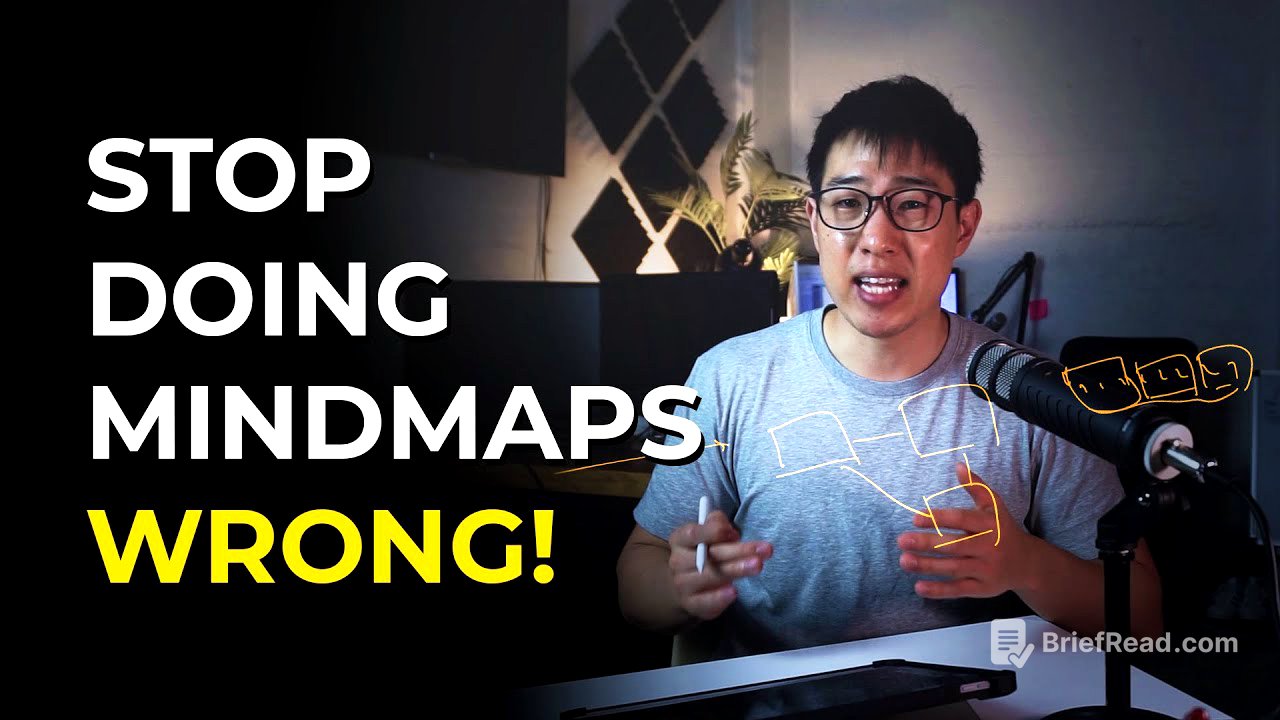TLDR;
This video explains how to create effective mind maps using the "GRIND" mnemonic (Grouped, Reflective, Interconnected, Non-Verbal, Directional, Emphasized). It emphasizes that mind mapping is a technical skill supported by research, improving metacognition, critical thinking, creativity, and knowledge retention. The video stresses the importance of deep processing and organizing information logically for enhanced learning.
- Mind maps are a research-backed tool for improving learning.
- The "GRIND" mnemonic provides a framework for effective mind mapping.
- Directionality and flow are crucial for logical organization and deep processing.
- Emphasizing key points enhances memory and prioritizes information effectively.
Introduction to Mind Mapping [0:00]
The video introduces the concept of mind mapping and addresses the common misconception that it's ineffective. Justin Sung argues that mind maps often fail because they are not implemented correctly, highlighting that mind mapping is a technical skill with specific guidelines. He asserts that when done right, mind mapping is a universally effective study technique, based on his experience coaching numerous students.
Research Supporting Mind Mapping [1:04]
The video presents research that supports the effectiveness of mind mapping. Studies show that mind maps improve metacognitive skills, critical thinking, creativity, and knowledge retention. One study found that students using inquiry-based learning combined with mind maps achieved the highest levels of critical thinking. Additionally, mind mapping enhances creative thinking by promoting synergy between different parts of the brain. Research also indicates that mind maps improve the recall of factual material, with retention rates being significantly higher compared to traditional study techniques, even when accounting for motivation levels.
The GRIND Mnemonic: Introduction [4:23]
The video introduces the "GRIND" mnemonic, which stands for Grouped, Reflective, Interconnected, Non-Verbal, Directional, and Emphasized. This mnemonic is based on Justin's experience coaching students and represents the key principles that make a mind map effective. He clarifies that this technique builds upon the foundational attributes of successful students and complements other learning strategies like deep processing and inquiry-based learning. The video emphasizes that the quality of the learning reflected in the notes is dependent on the quality of the learning process itself.
Grouped [5:29]
The "Grouped" principle involves organizing ideas into categories and boxes to simplify knowledge and make it more manageable. Instead of learning numerous individual facts, grouping them into categories helps create connections and integrate smaller concepts into the larger picture. This approach allows for greater flexibility in rearranging and connecting concepts, similar to using tree branches for construction rather than individual leaves.
Reflective [7:09]
The "Reflective" principle emphasizes that notes should mirror the thought processes occurring in one's mind. Traditional linear note-taking, which involves writing left to right in lists or paragraphs, is often ineffective because it doesn't align with how we naturally think. Breaking away from linear note-taking can lead to more time-efficient and effective learning, reducing the need for repetitive revisions.
Interconnected [8:25]
The "Interconnected" principle involves linking ideas and categories of information, even those that may not initially seem connected. This approach encourages the discovery of new and meaningful connections, fostering a more holistic understanding of the subject matter. By preventing knowledge from becoming isolated, interconnectedness strengthens the connections between concepts, making them more memorable.
Non-Verbal [9:04]
The "Non-Verbal" principle suggests using creative methods of expression, such as doodles, arrows, symbols, and shorthand, rather than relying heavily on words. This approach saves time and enhances knowledge retention and depth. Overcoming the initial insecurity of removing words and embracing visual representations can significantly improve the effectiveness of mind maps. Even simple stick figures and abstract drawings can effectively represent ideas, making the mind map more engaging and memorable.
Directional [10:51]
The "Directional" principle focuses on arranging connections in a specific order to create flow. This involves establishing cause-and-effect relationships between ideas, which enhances logical organization and deep processing. Directionality allows learners to understand not only the concepts themselves but also how they relate to each other, their purpose, and where they lead. A well-organized mind map with clear directionality reflects a high level of critical thinking and deep processing.
Emphasized [13:10]
The "Emphasized" principle involves making the main points of a mind map more distinctive through visual cues like thicker lines, larger font sizes, and word art. This enhances the technique by making it easier to navigate and revise the information. Emphasizing key points forces learners to prioritize information and create a hierarchy of knowledge, which is a higher level of mastery. This approach improves the overall cohesiveness of the mind map and facilitates quick identification of main connections and information flow.
Conclusion [16:55]
The video concludes by reiterating the importance of combining the GRIND principles with deep processing to achieve effective learning. It encourages viewers to share their experiences with note-taking and mind mapping in the comments. The video also promotes Justin's course, which covers mind mapping in more depth and critiques various mind maps to illustrate best practices.









